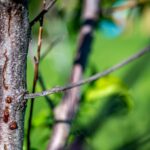Peach Tree Borer
Leaf Feeding Insects & Mites
The Peach Tree Borer (Synanthedon exitiosa) is a species of clearwing moth that is native to North America. The larvae of this insect feed on the inner bark and cambium layer of various species of deciduous trees, including peach, plum, cherry, and apricot. The damage caused by the borer can weaken or kill young trees and significantly reduce the yield of mature trees.
Adults have a wingspan of about 1.5 inches and are typically black with red or yellow stripes. They are most active in the summer and lay their eggs on the trunk of the tree, near pruning cuts, wounds or the soil line. The eggs hatch into larvae, which then burrow into the tree, creating a tunnel and feeding on the inner bark and cambium layer.
The presence of the Peach Tree Borer can be identified by the presence of holes or exit holes in the trunk and the presence of sawdust at the base of the tree. In severe cases, wilting, yellowing, and death of the top of the tree may also be observed.
Control of the Peach Tree Borer can be difficult, but several methods are available for management. Preventative measures such as maintaining tree health, avoiding stress, and avoiding wounds during pruning can help reduce the risk of infestation. Chemical treatments are also available for management, but should be used with caution as they can be harmful to beneficial insects and other wildlife. In some cases, trunk injections or soil drenching with insecticides may be necessary to control severe infestations.



